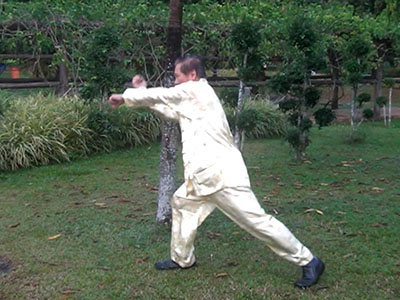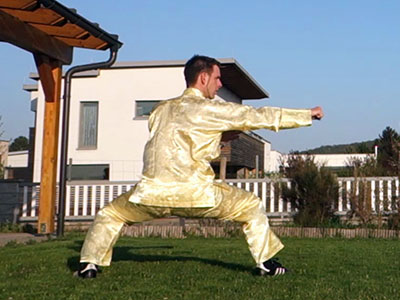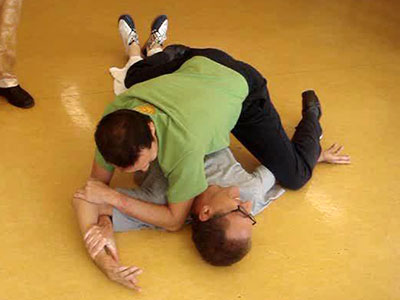OTHER KUNGFU ANIMALS
Sifu Leonard Lackinger, Shaolin Wabnam Austria

The Monkey Style is one of the most popular and trickiest of the animal styles
The Monkey
The monkey is always good for a surprise and likes playing his numerous tricks. Because of his agility, he is also hard to catch. He is characterized by playfulness, curiosity and cheekiness. Never trust a monkey! He likes stealing "peaches".
Another characteristic of the monkey is internal force, which enables him to be relaxed and graceful, but at the same time very powerful.
Sifu's master, Sigung Ho Fatt Nam, was a monkey specialist. Sifu only learned a few characteristic techniques and applications from him. Later, by combining the techniques he learnt with those from another set, he developed the "Shaolin Monkey Set" of our school, which contains all the important features of Monkey Kung Fu. While the monkey style is more suitable for small, nimble practitioners, a few gorilla techniques are also included for the big and strong fighters.
Shaolin Monkey Set from Wong Kiew Kit on Vimeo.
Choose video here:
- Shaolin Monkey Set
- The Spirit of the Monkey
- Pattern Analysis of the Monkey Set
- Interesting Monkey patterns that are deadly for combat
- Black Ape Shows Rage of Shaolin Monkey Set
The Praying Mantis
The Praying Mantis also stands for agility, likes to hammer its "crushing fist" on the opponent's head, hooks the neck with the "mantis hand", while the leg is pulled away, or kicks against the opponent's foot or shinbone by using the typical "Seven-Star-Step" while punching simultaneously.
Praying Mantis Kung Fu has been developed by the Shaolin disciple Wang Lang and has produced respective styles ("Tang Lang") in both the north and south of China. Particularly noteworthy is Wang Lang's "Praying Mantis 18 Collection". For this, he collected the best Kung Fu techniques of his time out of 18 different styles.
Praying Mantis Eighteen Collection Set from Wong Kiew Kit on Vimeo.
Choose video here:
- Praying Mantis 18 Collection Set
- Functions and Evolution of Praying Mantis Seven-Star Step
- Crushing Fist of Praying Mantis Kung Fu
- Cotton Palm, Bosom Fist and Mantis Hook of Praying Mantis Kung Fu
The Eagle
The eagle is characterized by a very powerful grip, which often serves as preparation for a decisive blow. Yue Fei, also known as the god of war, righteousness or martial arts, trained his soldiers in the Eagle Claw Kung Fu he developed.
The style is crystallized in 50 combat sequences for various situations in combat, and often makes use of holding and gripping techniques that are meant to immobilize the opponent for a final, decisive strike.
Eagle Calw Combat Sequences 1 to 5 from Wong Kiew Kit on Vimeo.
Biodiversity in Xingyiquan
Yue Fei's generals, in turn, were inaugurated into his art of Xingyiquan. This internal martial art has even 12 animal forms. The characteristics of these animals, however, are not as pronounced, holistic and internal as the classic five Shaolin animals. In fact, the animal forms of Xingyiquan describe rather external, localized expressions:
- Dragon -- contracting and expanding
- Tiger -- courage
- Monkey -- agility
- Horse -- speed
- Alligator -- gliding
- Cockerel -- combative
- Hawk -- soaring
- Swallow -- skimming
- Snake -- sliding
- Ostrich -- ramming
- Eagle -- gripping
- Bear -- stability
While the animal spirits in Shaolin Kung Fu are more concerned with the internal essence than the outer appearance, the animal styles in the Xingyi are clearly discernible on the outside. Whenever you need to glide in your daily life, you will be able to do better with the Xingyiquan training. However, the effect is not as comprehensive as developing internal force with the tiger spirit of Shaolin Kung Fu, which can improve any activity in life.
The Elephant
After the largest land animal, a rather unknown style is called "Elephant Fist", in which the arms are swung like an elephant's trunk.
An elephant fist is found in some styles. While in the Phoenix-Eye fist the pointing finger protrudes from the fist to hit vital points exactly, in the elephant fist it is the middle finger.
The "Elephant-Step" is used, for example, when the opponent holds our foot after a kick, as in the seventh combat sequence of our Taijiquan.
The pattern "Old Elephant Drops Tusk", which occurs in the "Taming the Tiger Set", combines attack and defence using the tactic "defence cum-counter".

Old Elephant Drops Task
Other Four-Legged Friends in the Chinese Arts
Another set of five animals is the "Five Animal Play" in Chi Kung, which is independent of the five animals of Shaolin Kung Fu. This joyous and effective art of Hua Tuo, the "god of medicine", consists of the bird, the tiger, the bear, the monkey and the deer. You can find out more about the "Five-Animal Play" and its effects, especially in solving pent-up emotions, here (in German).
In the history of Chinese martial arts, there were always some further animal styles, but they were not widely used. Among the more recent developments are the dog and the somehow comical Duck Kung Fu, while the duck also has its regular place in our Shaolin Kung Fu repertoire with the pattern "Precious Duck Swims through the Lotus".

"Precious Duck Swims through Lotus" resembles a swimming duck
In modern Wushu performances other animals such as the scorpion, the tortoise and the frog are presented. These, however, do not have a significant inner component, apart from training acrobatics and agility, and have at least not been established as traditional styles. Nevertheless, there are also some classical references to the mentioned animals.
In the art of "Five Poisons Hand", among other things, practitioners are required to get stung in the hand by scorpions, in order to collect poison there, which shall poison the enemy on contact. However, whether there were really any masters who had trained in this peculiar and dangerous method and preferred it to the high-quality internal arts, remains unresolved.
Tortoise Breathing is a proven breathing technique in Chi Kung to achieve longevity. A training method for internal force in Shaolin Wahnam, in which we move, so to speak, in slow motion, is called "Black Tortoise Method".
And a ground technique of the Shaolin Kung Fu is named "Green Frog Crouching on Ground".

In a frog posture an opponent can be pinned-down very well
The king of the animals could not get hold of its own style, but it is notable in the patterns "Spiritual Lion Opens Mouth", "Lion Rolls Ball" and "Warrior Plays with Lion". In addition, the traditional Chinese lion dance is closely linked to Kung Fu culture. Lion dance, by the way, is one of the many specialties of our grandmaster, in which he trained several champions.
Unfortunately, Pandas are not included in traditional Kung Fu. For this, we can enjoy an innovation of the film industry.
Author: Sifu Leonard Lackinger
LINKS
Courses and Classes
